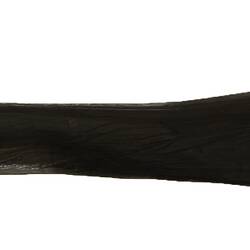Summary
The traditional lands of the Kaurna people include the area around South Australia's Adelaide Plains. Like many of the south-eastern groups in Australia, the Kaurna had an abundance of food available to them, feasting on fish, birds and game during the summer months and retreated inland during the winter months.
Kaurna men would hunt large game such as kangaroo using a lightweight hunting spear two to three metres long, and a small spear-thrower carved from lightwood such as the casuarina. Using a small spear thrower a skilled hunter could propel his spear a great distance, up to 30 metres, with accuracy.
Men would be very careful with their spear thrower and hunting spear. When a hunting spear was broken, by accident or in the chase of the hunt or in battle, the body of the implement was kept and a new hook fitted, using either wood, animal bone or even the incisor tooth of a kangaroo.
Local Name
Midla
Physical Description
Elongated elliptical shaped spearthrower. Handle cylindrical with a knob of gum cement and fibre at the end. Peg attached to shaft with gum cement and fibre. No decoration.
Significance
This spear thrower was made and used by the Kaurna peoples of the Adelaide Plains, South Australia, whose lands extend from Cape Jervis at the bottom of the Fleurieu Peninsula to Port Wakefield in the east and as far north as Crystal Brook. In recent times there has been a revival of Kaurna language and the Kaurna people's culture and history are at the fore in Adelaide through major public artworks in prominent locations which incorporate Kaurna language and themes. The Adelaide City Council has worked with prominent Kaurna Elders to enact a place-naming initiative which has seen all the city parks, squares and the river which runs through the city reinscribed with Kaurna names.
More Information
-
Object/Medium
Spearthrower
-
Maker
-
Cultural Groups
-
Locality
-
Date Produced
-
Collector
-
Date Collected
-
Object Measurements
590 mm (Length), 90 mm (Width), 35 mm (Height)
-
Classification
-
Date Made
-
Maker
-
Clan/Language Group
-
Place Made
-
Indigenous Region
-
Collection Names
-
Type of item
-
Discipline
-
Category
-
Collecting Areas



